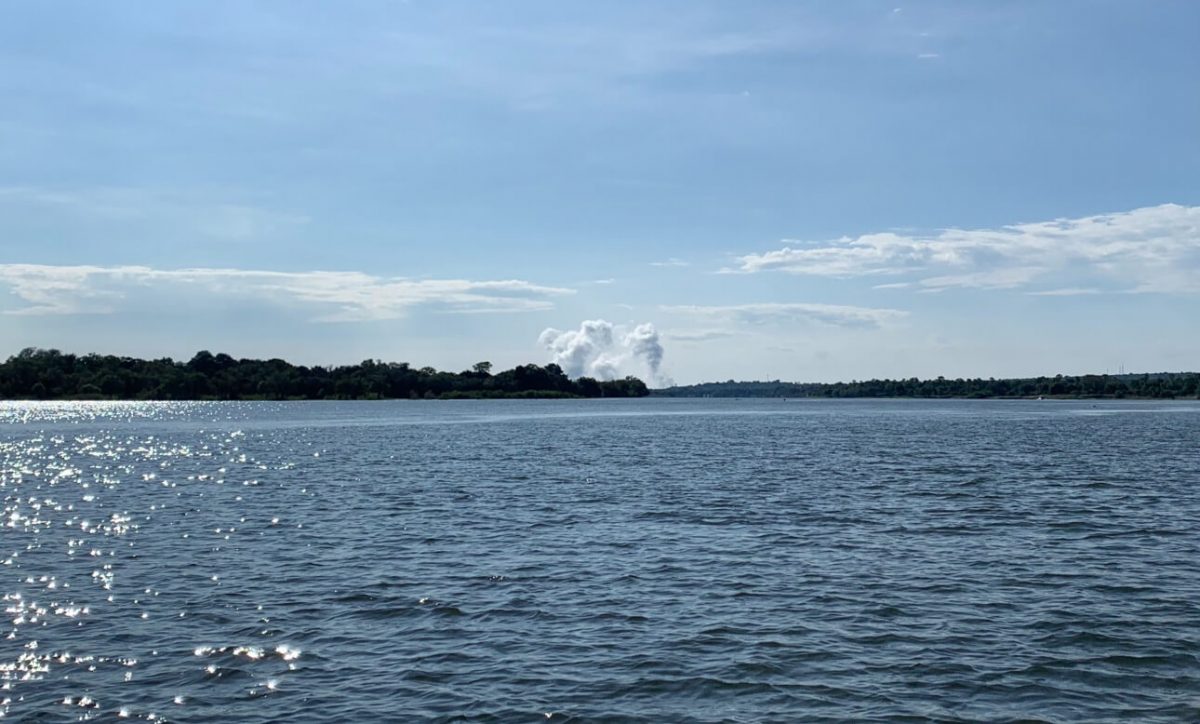The Zambezi here at the Falls is rising quickly; flows at Victoria Falls increased to 457m3/s on 14th January 2020.
Last year on the same date, the flow was 416m3/s, an increase of 21%. Most of the rain in an average season should fall in January, February and March, so all hope is not lost yet. In the early mornings, the spray from The Falls is starting to climb higher and higher into the sky, and our guests are getting happily soaked by the spray on their hikes through the rain forest.  As always, there are positives that come with the low rainfall; we have remarkably few mosquitoes around at present. A plague of moths has however taken their place, and they emerge at dusk in their hundreds. Turning down all the lights on the deck and in the bar definitely helps, and leaving a glass of red wine out seems to draw them away from visiting other drinks. We had guests arrive from the Okavango and Savuti recently, and they said that the moth plague was worse there than it is here. Their numbers are starting to recede now, but I have no doubt that another member of the insect family is about to start its mass birth cycle in replacement. Such is life in the bush! We have only one specimen of Ficus Burkei (the common strangler fig) on the Island. It is just south of the generator and water tanks, and is slowly doing its best to overpower a huge ebony.
As always, there are positives that come with the low rainfall; we have remarkably few mosquitoes around at present. A plague of moths has however taken their place, and they emerge at dusk in their hundreds. Turning down all the lights on the deck and in the bar definitely helps, and leaving a glass of red wine out seems to draw them away from visiting other drinks. We had guests arrive from the Okavango and Savuti recently, and they said that the moth plague was worse there than it is here. Their numbers are starting to recede now, but I have no doubt that another member of the insect family is about to start its mass birth cycle in replacement. Such is life in the bush! We have only one specimen of Ficus Burkei (the common strangler fig) on the Island. It is just south of the generator and water tanks, and is slowly doing its best to overpower a huge ebony.
The fig is in full fruit now, and it is attracting lots of birds that we don’t often see on the Island.
Flocks of the African Green Pigeon arrive every day to feast, and this morning I was awakened by the screeching of Grey-Headed Parrots. Trumpeter Hornbills are here year-round, and they too love the figs. Our small troop of vervet monkeys make up the numbers. As the water level rises, Cyperus papyrus is growing fast in the shallows around the jetty. This species of aquatic flowering plant belongs to the sedge family Cyperaceae. It is a tender herbaceous perennial, native to Africa, and forms tall stands of reed-like swamp vegetation in shallow water.
Papyrus sedge has a very long history of use by humans, notably by the ancient Egyptians. It is the source of papyrus paper, one of the first types of paper ever made.
Parts of the plant can be eaten, and the highly buoyant stems can be made into boats. It grows in full sun, in flooded swamps, and on lake margins throughout Africa, Madagascar, and the Mediterranean countries.  I have talked in previous blogs about the Nile Monitor Lizard (Varanus niloticus). They are big bulky reptiles, and Africa’s longest lizard. We have a large number of them on the Island. They can reach a length of two meters, of which more than half is tail. They don’t move far from water, and I see them every day on my travels. They are versatile and fast-moving predators, able to swim, run and climb.
I have talked in previous blogs about the Nile Monitor Lizard (Varanus niloticus). They are big bulky reptiles, and Africa’s longest lizard. We have a large number of them on the Island. They can reach a length of two meters, of which more than half is tail. They don’t move far from water, and I see them every day on my travels. They are versatile and fast-moving predators, able to swim, run and climb.
Nile Monitors eat all manner of prey, from insects to small mammals, using their forked tongues to track down quarry by scent. They are definitely stalking the baby banded mongooses, but at the time of writing the clan still has all six.
 One late afternoon in early January, I was watching TV in my tent situated on the western side of the Island.
One late afternoon in early January, I was watching TV in my tent situated on the western side of the Island.
I heard an unfamiliar noise outside and saw a hippo grazing. Riding on his back was a Red-billed Oxpecker, a new bird species for the Island.
Please excuse the sound of CNN off my TV in the background!



